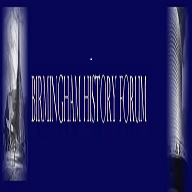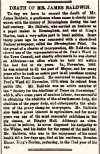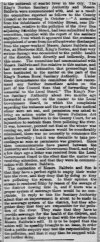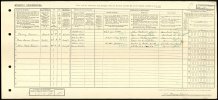Hello! Prompted by my conversations with him, my Baldwin family contact Louis (parents Cyril and June) actually wrote to your mother last year at the last address he had for her, and it was recently returned to him as "not at this address". I know he would be very glad to make a connection again. I would be happy to facilitate that, if your mother would be interested.Hello my mother is Victoria Baldwin whos bloodline is relative and my mother still here says she has the photo of the paper mill and remembers visiting when she was a child. Her father was Sidney Walter Baldwin married to Pauline Peutherer. I have asked her to sign up to this forum.
-
Welcome to this forum . We are a worldwide group with a common interest in Birmingham and its history. While here, please follow a few simple rules. We ask that you respect other members, thank those who have helped you and please keep your contributions on-topic with the thread.
We do hope you enjoy your visit. BHF Admin Team
You are using an out of date browser. It may not display this or other websites correctly.
You should upgrade or use an alternative browser.
You should upgrade or use an alternative browser.
Sherbourne Mill / Baldwin & Sons Paper Mill
- Thread starter illumina3
- Start date
I will see if I can figure out again how to send you a private message so I can facilitate the connection.H
Hi Michelle. I am i think the last female direct descendant of the James Baldwin family. I have not been back to the UK in a very long time and have lost touch with any of my relatives there from my fathers side of the family. I think i have seen the portraits you are referring to. I visited my great aunt Daphne Baldwin many years ago and they were hanging in her home. Could you pls tell me somehow who was the descendant you were speaking to over there. Im aware i had cousins over there but do not know how to contact them. Many thanks.
I just sent you a private email via this website. Let me know if you want to take discussion further!H
Hi Michelle. I am i think the last female direct descendant of the James Baldwin family. I have not been back to the UK in a very long time and have lost touch with any of my relatives there from my fathers side of the family. I think i have seen the portraits you are referring to. I visited my great aunt Daphne Baldwin many years ago and they were hanging in her home. Could you pls tell me somehow who was the descendant you were speaking to over there. Im aware i had cousins over there but do not know how to contact them. Many thanks.
I have my copy of Lucy Lethbridge's book open in front of me. Fascinating! Thank you for alerting us to the appearance of a Baldwin household in this book. It is not the best footnoted text, unfortunately. My suspicion is that the Alice Osbourn journal remains in private hands, as it is footnoted simply as "Osbourn diaries." (It does not appear in the National Archives' listings of records in publicly accessible repositories.) The only way to find it would probably be to contact Lucy Lethbridge. I see from her acknowledgements that it was brought to her attention by someone called Crispin Jackson, in case that is a name that means anything to you. I just sent Lethbridge a Twitter message about it. We shall see if she responds.
JenResearcher
Brummie babby
Hi everyone,
It was really great to find this thread - I am currently researching for a women's history walk in Birmingham and our route takes us past the old Sherborne Mill at Sherborne Wharf in Ladywood, at what was Morville Street.
I was wondering if there's much known about the lives of the women of the Baldwin family, or if much is known about women workers in paper mills that would be of interest for our walk? If anyone could point me in the right direction that would be greatly appreciated!
I'm currently looking into Louisa Ryland, who I discovered owned the land through your article Michelle! I really enjoyed reading your article in The Local Historian, and I look forward to reading more about the Baldwin family.
Many thanks all.
It was really great to find this thread - I am currently researching for a women's history walk in Birmingham and our route takes us past the old Sherborne Mill at Sherborne Wharf in Ladywood, at what was Morville Street.
I was wondering if there's much known about the lives of the women of the Baldwin family, or if much is known about women workers in paper mills that would be of interest for our walk? If anyone could point me in the right direction that would be greatly appreciated!
I'm currently looking into Louisa Ryland, who I discovered owned the land through your article Michelle! I really enjoyed reading your article in The Local Historian, and I look forward to reading more about the Baldwin family.
Many thanks all.
Hello! Glad you enjoyed my article. You can note to your walkers that the 1829 date on the frontage of the Sherborne Mill building is a fictionHi everyone,
It was really great to find this thread - I am currently researching for a women's history walk in Birmingham and our route takes us past the old Sherborne Mill at Sherborne Wharf in Ladywood, at what was Morville Street.
I was wondering if there's much known about the lives of the women of the Baldwin family, or if much is known about women workers in paper mills that would be of interest for our walk? If anyone could point me in the right direction that would be greatly appreciated!
I'm currently looking into Louisa Ryland, who I discovered owned the land through your article Michelle! I really enjoyed reading your article in The Local Historian, and I look forward to reading more about the Baldwin family.
Many thanks all.
There are no surviving records for the Baldwin firm, so far as I know, except for a small amount in private hands (descendants who don't live in Birmingham), and none of those include employee records of any kind. I think that the Warwickshire photographic survey (held by the Library of Birmingham) may hold some photos relating to the Smith, Stone & Knight mills - I have seen copies in those private collections - but not of the Baldwin mills.
The Baldwin family excluded the women of the family from any active role in managing the mill or business. As I did my research, I became quite annoyed on their behalf! They figure in the family story as wives and daughters, and inheritors of land/property. The various Mrs James Baldwins did, of course, help to host the annual employee shindig at the family estate in Kings Norton. The first Mrs Baldwin (Mary Allport) came from a gun-making family. The second Mrs Baldwin (Susannah Billing) was a cousin who died at 51 of uterine cancer; and the third Mrs Baldwin (Mary Upton) was her husband's niece by marriage! I have a full family tree back to James Baldwin's parents and there really are no notable female stories to tell (that I have found so far - always looking!).
As for the women workers, I am actually a good part through writing a follow-up article on paper workers in Birmingham using the census and other genealogical records. There were plenty of women paper workers in Birmingham - though remember it was a small paper centre compared to other parts of Britain like Kent and Lancashire. Paper making was a highly gendered industry. Paper makers (i.e. beatermen, machinemen) did an apprenticeship, which was not open to women. Women did not (or at least were not formally trained to, or expected to) use any of the paper-making machinery. Women workers had two main roles in the paper mill.
First, they worked at the "wet end" of the process, in the rag chopping room. Their job was to sort and cut up the rags (raw material for the paper), typically using a blade that was wedged upright in a table. About four inches square was what was required. Rags were sorted by colour. Buttons, seams and other imperfections needed to be removed. Then the rags would go into the beater for preparation to be "stuff", which would eventually become paper. Rag rooms were notorious for their dusty, poorly ventilated conditions. There were also periodic scares (not just in Birmingham) about the rags spreading infectious diseases. Some of this was real risk, and some of it was xenophobic, as the rags were imported!
Second, women worked at the "dry end" of the process, in the "salle", which is where the finished paper would come for checking and packing. Supervisors were usually men.
Baldwins also employed women as clerks, at least in the early 20th century. The plans for the 1908 rebuild show that there was a lavatory area for the "lady clerks."
When the paper-making process was relocated to Baldwin's new mill in Kings Norton, the mill in Ladywood became a warehouse and print shop. Note that a warehouse wasn't just a place for storing products, it was a place for displaying them to potential customers. The census shows quite a few warehouse women/girls in the area around Sherborne St, but of course Baldwin's was not the only warehouse in the area, so it isn't possible to tell who worked in which industry.
Women workers were also much employed making paper boxes and bags - in fact, box making was the big growth area for employment between 1851 and 1901, which is not a surprise when you think about the many Brummie industries that paper was serving. Some of this bag and box making was sweated/home work labour, but some of it was also done in the mills. Baldwins had a large paper bag making department which was mainly staffed by women. Women were also engaged in making Baldwin's highly successful gun-wadding, which was exported to the USA, India, Canada, Jamaica and other places.
I hope that's helpful. Please recommend my article to any of your walkers who are interested in learning more about Birmingham's paper history; I think it is no longer behind the BALH firewall!
Last edited:
Pedrocut
Master Barmmie
There is a Thread for John Benjamin Stone.
“It was not only the glassworks that made John Benjamin a fortune, but also his school friendship with Smith and Frederick Knight and the pact they made to go into business. They formed Messrs Smith, Stone and Knight and began to build a paper mill empire. "So out of an enterprise conceived at school the three families enjoyed ample fortunes." He also had an eye for success in business ventures at a comparatively early age, including being a director on the Argus Assurance Co.”
 birminghamhistory.co.uk
birminghamhistory.co.uk
“It was not only the glassworks that made John Benjamin a fortune, but also his school friendship with Smith and Frederick Knight and the pact they made to go into business. They formed Messrs Smith, Stone and Knight and began to build a paper mill empire. "So out of an enterprise conceived at school the three families enjoyed ample fortunes." He also had an eye for success in business ventures at a comparatively early age, including being a director on the Argus Assurance Co.”
Benjamin Stone.
--- I have used the Forum search box for this man but to no avail, The first picture is a photograph and the second one is a painting of this great man. John Benjamin Stone, son of Benjamin Stone, a glass manufacturer, was born in Aston Birmingham in 1838 and was educated at King Edwards...
 birminghamhistory.co.uk
birminghamhistory.co.uk
Yes, Baldwin had several very nice obituaries. The one in the Unitarian journal (the title of which is escaping me at this precise moment) is particularly warm. His funeral at the Kingswood Meeting House in Kings Norton was attended by a cavalcade of local politicians and other high status mourners.
daveevans2010
master brummie
Resource Details - Birmingham Images
Images, documents and views from the past for the area where you live, work or visit.
www.search.birminghamimages.org.uk
Pedrocut
Master Barmmie
Messrs Baldwin and Son polluting the River Rea..
(December 1889, Birmingham Daily Post.)
View attachment 160741
A Further report from Dec 1889.
During the past 2-3 years grave complaints received of the foul character of the River Rea.
Reported more than once and also by the Medical Officer of Health. Primary allegation that the river is polluted by effluent discharged by Baldwin paper works. In July notice given to Baldwin to refrain.
For many years complaints made to Sanitary Committee and were effected on a very temporary character. Difficulties had arisen as a member of the firm of Baldwin was also a member of the Sanitary Authority.
Farmers wrote to George Cadbury. One milk seller lost customers due to the quality of milk produced by the cows drinking the water, and there was a suspect death of a child due to this.
Mr Lowcock…“There is not the slightest doubt that practically the whole of the nuisance is caused by effluent from Baldwin's mills.”
The report of the sanitary Committee was considered grave and that measures should be taken at once. There was a feeling that the distribution of the milk in Birmingham had contributed to the outbreak of scarlet fever.
Pedrocut
Master Barmmie
The saga continues and here is a brief summary. There are many more details in the Press for anyone to study in depth.
March 1890…Problem still not resolved. Local Government Enquiry.
August 1890 Still complaints, also against Messrs Baldwin paper mill polluting the canal. Letter to be sent.
October 1890 another meeting and the enquiry was adjourned for 3 Months.
November 1890 Rev CH Coates Reedy said for the last six years complaints had been received by the Authority and they had absolutely refused to take action. Mr. Pritchett for Baldwins admitted that there was considerable pollution of the river, but they would be able to show that every practical and reasonable means were used to check the effluent.
February 1891. Baldwins were conducting certain operations which might obviate the further pollution of the river. It was decided to await the result of these operations before taking further action in the matter.
November 1892 adjourned enquiry continues. Messrs Baldwin had not completed the operations, and nothing substantial had been done. It was decided that the enquiry should be commenced de novo. The effluent from the works was about 300,000 gallons a day, and from sewage 100,000 gallons per day. The enquiry terminated with the Inspector saying his report would be submitted to the Local Goverment Board.
February 1893 the Local Government Board give consent to take proceedings against Messrs Baldwin.
May 1893 the Authority to make one more plea to Messrs Baldwin.
August 1893 the River Rae is in a terrible state and the Authority vote to send notice to Messrs Baldwin requesting to stop !
November 1893 Baldwins are now taking immediate steps to abate the nuisance by putting down a very expensive patent system. Proposal that no proceedings taken and trial should be allowed.
August 1894 Resolution carried to receive the liquids proceeding from Messrs Baldwin's factory if they could satisfy the Authority that the liquid was not in contravention of the Rivers Pollution Act.
March 1890…Problem still not resolved. Local Government Enquiry.
August 1890 Still complaints, also against Messrs Baldwin paper mill polluting the canal. Letter to be sent.
October 1890 another meeting and the enquiry was adjourned for 3 Months.
November 1890 Rev CH Coates Reedy said for the last six years complaints had been received by the Authority and they had absolutely refused to take action. Mr. Pritchett for Baldwins admitted that there was considerable pollution of the river, but they would be able to show that every practical and reasonable means were used to check the effluent.
February 1891. Baldwins were conducting certain operations which might obviate the further pollution of the river. It was decided to await the result of these operations before taking further action in the matter.
November 1892 adjourned enquiry continues. Messrs Baldwin had not completed the operations, and nothing substantial had been done. It was decided that the enquiry should be commenced de novo. The effluent from the works was about 300,000 gallons a day, and from sewage 100,000 gallons per day. The enquiry terminated with the Inspector saying his report would be submitted to the Local Goverment Board.
February 1893 the Local Government Board give consent to take proceedings against Messrs Baldwin.
May 1893 the Authority to make one more plea to Messrs Baldwin.
August 1893 the River Rae is in a terrible state and the Authority vote to send notice to Messrs Baldwin requesting to stop !
November 1893 Baldwins are now taking immediate steps to abate the nuisance by putting down a very expensive patent system. Proposal that no proceedings taken and trial should be allowed.
August 1894 Resolution carried to receive the liquids proceeding from Messrs Baldwin's factory if they could satisfy the Authority that the liquid was not in contravention of the Rivers Pollution Act.
mw0njm.
A Brummie Dude
very interesting reading ta pThe saga continues and here is a brief summary. There are many more details in the Press for anyone to study in depth.
March 1890…Problem still not resolved. Local Government Enquiry.
August 1890 Still complaints, also against Messrs Baldwin paper mill polluting the canal. Letter to be sent.
October 1890 another meeting and the enquiry was adjourned for 3 Months.
November 1890 Rev CH Coates Reedy said for the last six years complaints had been received by the Authority and they had absolutely refused to take action. Mr. Pritchett for Baldwins admitted that there was considerable pollution of the river, but they would be able to show that every practical and reasonable means were used to check the effluent.
February 1891. Baldwins were conducting certain operations which might obviate the further pollution of the river. It was decided to await the result of these operations before taking further action in the matter.
November 1892 adjourned enquiry continues. Messrs Baldwin had not completed the operations, and nothing substantial had been done. It was decided that the enquiry should be commenced de novo. The effluent from the works was about 300,000 gallons a day, and from sewage 100,000 gallons per day. The enquiry terminated with the Inspector saying his report would be submitted to the Local Goverment Board.
February 1893 the Local Government Board give consent to take proceedings against Messrs Baldwin.
May 1893 the Authority to make one more plea to Messrs Baldwin.
August 1893 the River Rae is in a terrible state and the Authority vote to send notice to Messrs Baldwin requesting to stop !
November 1893 Baldwins are now taking immediate steps to abate the nuisance by putting down a very expensive patent system. Proposal that no proceedings taken and trial should be allowed.
August 1894 Resolution carried to receive the liquids proceeding from Messrs Baldwin's factory if they could satisfy the Authority that the liquid was not in contravention of the Rivers Pollution Act.
BrianE
knowlegable brummie
In 1921 my Great Aunt Rose Annie Timms a single lady all her life was working as a paper bag maker for James Baldwin and sons of Morville Street, Ladywood Birmingham. She was a paper bag maker all her life even in September 1939. She was still working as a paper bag maker although it was as most probably just part time by then.
In those days people worked for the same company doing exactly the same job all their lives. I know this because her younger sister Alice Kate Timms whom I knew worked for JB Brooks and Company as a leather preparer for over 50 years, her work was recognised by a clock which I saw as a young person and a short article in the Birmingham Gazette newspaper.
In those days companies acknowledge the value of loyal long-term employees, something that still existed in the 1960s when I was a young person.
In those days people worked for the same company doing exactly the same job all their lives. I know this because her younger sister Alice Kate Timms whom I knew worked for JB Brooks and Company as a leather preparer for over 50 years, her work was recognised by a clock which I saw as a young person and a short article in the Birmingham Gazette newspaper.
In those days companies acknowledge the value of loyal long-term employees, something that still existed in the 1960s when I was a young person.
lovely memories brian...i agree with you that back in those days long term employees were rewarded well and it was nice to know that they were appreciated...do not know exactly when but i would think this started to drop off during the 80s/ 90s although maybe not with all firms..
lyn
lyn



